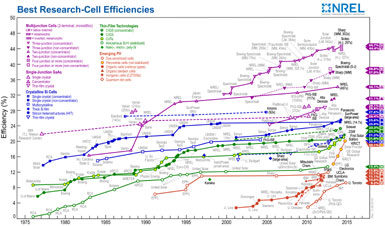Over the past few months, we’ve seen announcements of solar cells that are reaching new heights for converting the sun’s energy into electricity, showing how quickly the technology is advancing.
The latest is from the Department of Energy’s National Renewable Energy Lab (NREL), which has demonstrated 45.7% conversion efficiency for concentrating solar cells – more than double the typical 20% efficiency today.
It greatly improves on earlier designs by incorporating an additional high quality absorber layer to achieve an ultra-high efficiency, says NREL.
Multijunction solar cells harvest sunlight by dividing the solar spectrum into portions that are absorbed by a material with a bandgap tuned to a specific wavelength range. Combining materials with optimal bandgaps is critical for high efficiency. The challenge is to maintain the high quality of the materials while integrating them into a complex cell capable of efficient photoconversion.
"The distinction of this multijunction device is the very high quality of the lattice-mismatched subcells," says Ryan France, who designed the solar cell. "Lattice-mismatched materials require the introduction of defects, called dislocations, into the device, which can drastically hinder device performance. NREL has learned to control and confine these dislocations to inactive regions of the device, allowing even highly mismatched material to be used in a multijunction cell."
This graph shows research achievements for all kinds of solar cells, with NREL’s new one reaching the highest level yet:

Prices Keep Dropping
In 2013, system prices for utility-scale solar PV fell below $2 per watt, and have continued declining this year to $1.80 per watt – 59% lower than in 2010, according to NREL and Lawrence Berkeley National Lab.
Prices for distributed solar PV systems dropped 12-19% in the US during 2013, and will decline another 3-12% this year, depending on where the system is located and market segment. Since 2010, installed prices are down 46%, because of lower equipment costs and streamlined installation practices. Residential solar now averages $3.29 per watt and those who lease systems pay $2.22 per watt, according to NREL.
"There are significant variations in reported pricing both geographically and across market segments due to a variety of factors, including value-based pricing based on local competition within the marketplace and prevailing electric retail rates. Other factors include differences in specific system configurations such as panel efficiency, mounting structure, and geographic location; and the time lags between commitments and commercial operation for utility-scale systems."
Industry analysts expect this trend to continue over the next couple of years, keeping the US on track to meet DOE’s SunShot target – reducing the cost of solar PV below $1 per watt by 2020.
In another report, The Effect of State Policy Suites on the Development of Solar Markets, NREL finds that falling solar prices are benefiting some states more than others. Those with strong policies for interconnection and net metering benefit the most, and the length of time these policies have been in place are also important indicators of market success.
Read our article, US Solar Rises 41% in 2013, Greatest Year on Record.
Learn more about NREL’s new solar cell:
